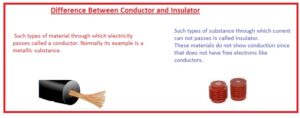 Hello, friends, I hope you all are doing great. In today’s tutorial, we will discuss the Difference Between Conductor and Insulator. The basic difference between conductor and insulator is that in conductor current can pass while in insulator current can not flow.
Hello, friends, I hope you all are doing great. In today’s tutorial, we will discuss the Difference Between Conductor and Insulator. The basic difference between conductor and insulator is that in conductor current can pass while in insulator current can not flow.
In today’s post we will have a detailed look at both conductor and insulator with the detailed compare them to find their differences. So let’s get started with Difference Between Conductor and Insulator.
Difference Between Conductor and Insulator
Conductor
- Such types of material through which electricity passes called a conductor. Normally its example is a metallic substance.
- Current is generated in the conductor due to free electrons, hols, and ions having positive and negative charges.
- the current can only pass in the conductor if it has a closed path.
- the value of current passing in the conductor relies on the resistance offered by the substance high resistance less current will flow low resistance high current will flow.
- There is an inverse relationship between the conductor and resistance.
- Resistance also depends on the length of the conductor.
- R=L/A
- From this equation, we can see that resistance is directly proportional to the length and inverse to the area of conductor.
- Lenght is measured in meter and area in meter square.
- Aluminum is used to make conductors of transmission lines.
- Mercury used in thermometer
What is Insulator
- Such types of substance through which current can not passes is called insulator.
- These materials do not show conduction since that does not have free electrons like conductors.
- Their high value of resistance stops to current flow.
- An example of this material is all types of nonmetals.
- There is no existence of the finest insulator materials since movable charges exist in insulators can cause current.
- If an electrical field in terms of high volts is given to insulating it will show a conductor-like feature.
- these materials are used with different electrical deice that provides porcelain form connection to other conductors.
- These substances also used as insulation material.
- Transmission line towers are also created with insulators
- Pin type insulator used in transmission line has pin-like configuration at top.
- They have a hole on upper part and the conductor can move from it.
- they employed fro thirty thee kilovolts lines
- Insulator employed in large voltage lines created with porcelain glass.
It is a detailed post about the difference between conductor and insulator if you have any further query ask in the comments. Thanks for reading.







